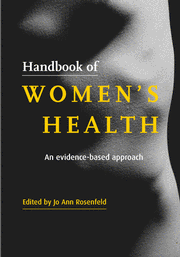Book contents
- Frontmatter
- Contents
- List of contributors
- Common abbreviations used in the text
- Normal blood values in women and during pregnancy
- Introduction
- 1 Singular health care of women
- Preventive care
- Psychosocial health
- Sexuality
- Genitourinary medicine
- 14 Menstrual disorders
- 15 Sexually transmitted diseases
- 16 Vaginitis
- 17 Chronic pelvic pain, dysmenorrhea, and dyspareunia
- 18 The Papanicolaou smear and cervical cancer
- 19 Endometrial cancer and postmenopausal bleeding
- 20 Ovarian cancer and ovarian masses
- 21 Urinary incontinence and infections
- Breast disorders
- Psychological disorders
- Common medical problems
- Index
19 - Endometrial cancer and postmenopausal bleeding
Published online by Cambridge University Press: 28 October 2009
- Frontmatter
- Contents
- List of contributors
- Common abbreviations used in the text
- Normal blood values in women and during pregnancy
- Introduction
- 1 Singular health care of women
- Preventive care
- Psychosocial health
- Sexuality
- Genitourinary medicine
- 14 Menstrual disorders
- 15 Sexually transmitted diseases
- 16 Vaginitis
- 17 Chronic pelvic pain, dysmenorrhea, and dyspareunia
- 18 The Papanicolaou smear and cervical cancer
- 19 Endometrial cancer and postmenopausal bleeding
- 20 Ovarian cancer and ovarian masses
- 21 Urinary incontinence and infections
- Breast disorders
- Psychological disorders
- Common medical problems
- Index
Summary
Endometrial cancer is the most common pelvic cancer but, luckily, it is usually discovered early and is often curable. Postmenopausal bleeding is worrisome because as many as one-quarter may be caused by cancer
Epidemiology
Endometrial cancer (ECa)(cancer of the body or corpus of the uterus) is the fourth most common malignancy in women in the USAand ranks seventh in cancer deaths in women. Since 1972, ECa has been the most common female pelvic malignancy. In the USA, 36,000 new cases are identified yearly and ECa caused 6300 deaths in 1998. In Europe, 5 percent of cancer in women is endometrial cancer.
Seventy-five percent of ECa occur in postmenopausal women, although 5 percent occur in women younger than age 40 years.
Because the primary symptom is postmenopausal bleeding, which is noteworthy and dramatic, most ECa cases are found at an early stage, have a good prognosis, and are usually curable by surgery.
Risk factors (Table 19.1) include use of unopposed estrogen, hyperestrogen states, and tamoxifen use. Other risk factors include obesity, nulliparity, diabetes, hypertension, chronic anovulation, PCOS, and estrogen-producing tumors. ECa is associated with early menarche and late menopause.
Use of tamoxifen for breast cancer therapy produces a sixfold increased risk in developing ECa at doses of 40 mg daily. Nonetheless, tamoxifen continues to be used, because the risk of ECa is much smaller than the risk of recurrent breast cancer.
[…]
- Type
- Chapter
- Information
- Handbook of Women's HealthAn Evidence-Based Approach, pp. 326 - 332Publisher: Cambridge University PressPrint publication year: 2001



